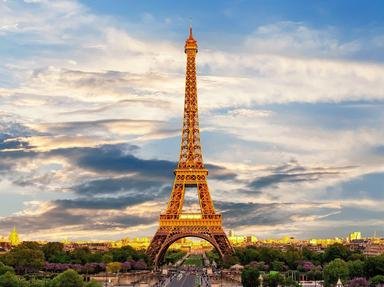Quiz Answer Key and Fun Facts
1. L'HISTOIRE. The caves at Lascaux would be an interesting place to eat fondue or fondants. The paintings were made over a series of generations and are mainly of animals such as aurochs and deer, and are thousands of years old. In which French department, in the southwest of France, are the caves located?
2. LA GÉOGRAPHIE. How about another nice picturesque location for eating fondues and fondants? Pictured is the Church of Notre-Dame de Louviers, located in a department in Normandy which takes its name from a river running through it. It's the 27th department of France, and its capital is Évreux. Which department is this?
3. LES ANIMAUX. The smell of your fondue may attract a dog with a strong nose. Which French scenthound is also known as the 'chien de Franche-Comté', and is named for its glossy white fur?
4. LE SPORT. Why not take your fondue and fondant to the Emirates Stadium to enjoy during an Arsenal match? The team, nicknamed the Gunners, moved there from Highbury, and it was opened in 2006. Which appropriately named French manager was in charge of Arsenal for over 20 years?
5. LES LOISIRS. Your average fondue usually contains cheeses such as Gruyère, Fantal or Emmental, but you probably wouldn't find a fondue made out of this cheese. It's made of sheep's milk and has distinctive blue veins. Accept no imitations! What is the name of this so-called King of Cheeses?
6. LES LETTRES. Would you really want to eat fondue or fondant out of this unorthodox container? Museums wouldn't thank you! It's actually a piece of modern art called 'Fountain'. The artist signed himself as 'Mutt', but what was his real surname?
7. LE CINÉMA. How about taking your fondue and fondant to the movies as a snack? Having said that, you might not want to eat while watching 'La Reine Margot' - it features arsenic poisoning and decapitation! Which French actress plays the title character, Margaret of Valois?
8. LA TÉLÉVISION. Why not settle down in front of the TV with your fondue and fondant, and watch this bizarre TV show that ran on Channel 4 from 1993 to 2007? It was presented by Antoine de Caunes and the designer Jean-Paul Gaultier, and often featured a pair of giraffes called Pipi and Popo who were made out of toilet roll tubes (hence the picture). What show is this?
9. LA MUSIQUE. It's not just fondue that has lots of cheese in it - so does the Eurovision Song Contest! France is one of the countries who has been in the contest from day one, and has won it several times. Which song, sung by Frida Boccara, represented France and was one of the four joint winning entries in 1969?
10. LES CÉLÉBRITÉS. And now for something completely different! The first letter of each answer so far will give you the tenth answer - it's the surname of a French actor who played Cyrano de Bergerac (pictured here), Obelix, and Honoré de Balzac, amongst others. Can you tell me who it is?
Source: Author
Kankurette
This quiz was reviewed by FunTrivia editor
agony before going online.
Any errors found in FunTrivia content are routinely corrected through our feedback system.
